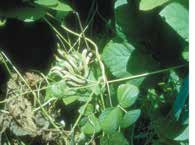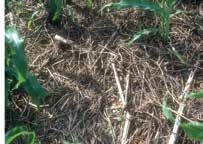chAPter 10 Cover CroPs
inoculant before planting. The addition of water or milk
hairy vetch produces a large amount of vegetation and
to the seed-inoculant mix helps the bacteria stick to the
fixes a significant amount of nitrogen, contributing 100
seeds. Plant right away, so the bacteria don’t dry out.
pounds of nitrogen per acre or more to the next crop.
Inoculants are readily available only if they are com-
Hairy vetch residues decompose rapidly and release
monly used in your region. It’s best to check with your
nitrogen more quickly than most other cover crops. This
seed supplier a few months before you need the inocu-
can be an advantage when a rapidly growing, high-
lant, so it can be specially ordered if necessary. Keep in
nitrogen-demand crop follows hairy vetch. Hairy vetch
mind that the “garden inoculant” sold in many garden
will do better on sandy soils than many other green
stores may not contain the specific bacteria you need; so
manures, but it needs good soil potassium levels to be
be sure to find the right one for the crop you are growing
most productive.
and keep it refrigerated until used.
Subterranean clover is a warm-climate winter
annual that, in many situations, can complete its life
Winter Annual Legumes
cycle before a summer crop is planted. When used this
Crimson clover is considered one of the best cover
way, it doesn’t need to be suppressed or killed and does
crops for the southeastern United States. Where
not compete with the summer crop. If left undisturbed,
adapted, it grows in the fall and winter and matures
it will naturally reseed itself from the pods that mature
more rapidly than most other legumes. It also contrib-
below ground. Because it grows low to the ground and
utes a relatively large amount of nitrogen to the follow-
does not tolerate much shading, it is not a good choice to
ing crop. Because it is not very winter-hardy, crimson
interplant with summer annual row crops.
clover is not usually a good choice for the regions where
significant frost occurs. In northern regions, crimson
Summer Annual Legumes
clover can be grown as a summer annual, but that pre-
Berseem clover is an annual crop that is grown as a
vents an economic crop from growing during that field
summer annual in colder climates. It establishes easily
season. Varieties like Chief, Dixie, and Kentucky Select
and rapidly and develops a dense cover, making it a
are somewhat winter-hardy if established early enough
good choice for weed suppression. It’s also drought tol-
before winter. Crimson clover does not grow well on
erant and regrows rapidly when mowed or grazed. It can
high-pH (calcareous) or poorly drained soils.
be grown in the mild climates during the winter. Some
Field peas are grown in colder climates as a sum-
newer varieties have done very well in California, with
mer annual and as a winter annual over large sections of
Multicut outyielding Bigbee.
the South and California. They have taken the place of
Cowpeas are native to Central Africa and do well in
fallow in some dryland, small-grain production systems.
hot climates. The cowpea is, however, severely damaged
Also called Austrian winter peas and Canadian field
by even a mild frost. It is deep rooted and is able to do
peas, they tend to establish quickly and grow rapidly
well under droughty conditions. It usually does better on
in cool moist climates, producing a significant amount
low-fertility soils than crimson clover.
of residue—2 1/2 tons or more of dry matter. They fix
Soybeans, usually grown as an economic crop for
plentiful amounts of nitrogen, from 100 to 150 or more
their oil- and protein-rich seeds, also can serve as a
pounds per acre.
summer cover crop if allowed to grow until flowering.
Hairy vetch is winter-hardy enough to grow well
They require a fertile soil for best growth. As with cow-
in areas that experience hard freezing. Where adapted,
peas, soybeans are easily damaged by frost. If grown to
104
Building SoilS for Better CropS: SuStainaBle Soil ManageMent









